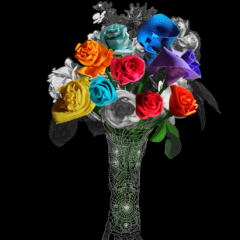For years, I had in my head a tiny exchange – a girl, in a film, maybe, or a play, talking to someone, in an American accent, about ‘blue roses’. It would come to me sometimes – on buses, while walking – but I could never remember where I’d heard it first. Even while I was writing the lyrics for the song, I couldn’t remember. Finally a trawl through Google revealed the source. It was a Tennessee Williams play called The Glass Menagerie. The production I’d seen had been at the Donmar Warehouse, in 1995, with Zoe Wanamaker in it, and Clare Skinner (of Outnumbered fame) playing the part of delicate Laura, who says:
‘When I had that attack of pleurosis – he asked me what was the matter when I came back. I said pleurosis – he thought I said Blue Roses!’
Blue Roses… all I remembered was the phrase, and it conjured the image of something improbable and beautiful, something that doesn’t exist in nature, something that must be created. And before I thought of Blue Roses, the first word I wanted to include in the song, and the word that fitted over the first chord of the chorus, which was my starting point, was this word:
writing
Because, for me, and for so many people, in so many ways, writing is a magic word. It even sounds inviting, with its smart inflections and clean lines, like a white-sailed boat, and its overtone of correctness: something right. What is more exciting than saying, ‘I can’t come out/meet you/pick up the phone, because I’m writing’? It doesn’t even matter what it is that’s being written: it’s the act of writing that moves us. (Writing something good is another matter altogether.)
So the lyrics of Blue Roses are all about writing. They are about making stuff. I wanted a mix of needlework and weaponry: embroidery, fishhooks, arrowheads, quilts, fabric, steel all feature. Writing is soft-edged and multilayered: there’s a lot of cross-stitching involved, of assembling swatches and weaving them together. (Intertextuality, although it’s an overused term, has always interested me greatly – how texts can be viewed as being ‘in conversation’ with each other, and indeed Robber Bride aims to do that, in a small way, in song. Weaving, knitting and so on are easy metaphors for intertextuality.) But there’s a harder side to writing, too: what you’ve written is yours, and it will be subjected to criticism and judgment, some of it welcome and useful, some of it less so. Weapons, resources, defences of some sort will be required. (I have never been very good at this, so partly the writing of these lyrics worked as a kind of self-help manifesto: how to try, if possible, not to take things personally.)
I wanted to call the album Blue Roses, for a long time (until we decided that Robber Bride was better). So when the brilliant Nigel Hardman and I were discussing ideas for the artwork, we used elements from both songs. I knew that I wanted weaving, in some capacity – for a while I thought about having Penelope at her loom. One of Nigel’s first ideas was a bouquet of flowers held by a gauntlet, and I loved it as soon as he suggested it. The final design is modelled on a photograph of my arm, and it’s being woven by a spider. The threads, all differently coloured, are linked to the roses (which Nigel made from felt and then photographed).
Here’s an early picture of the roses-in-progress:

